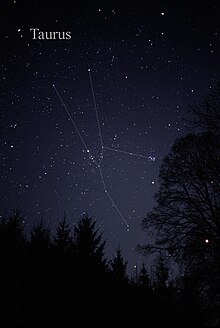Aldebaran
|
Star Aldebaran (α Tauri) |
|||||||||||||||||||||||
|---|---|---|---|---|---|---|---|---|---|---|---|---|---|---|---|---|---|---|---|---|---|---|---|

|
|||||||||||||||||||||||
| Size comparison, in descending order of size: Rigel , Aldebaran , Gamma Orionis , Algol B and the sun . The faint yellow sphere centered on the sun shows a radius of one minute of light . The large yellow ellipse roughly marks the orbit of the planet Mercury around the sun. Click on the picture for more size comparisons. |
|||||||||||||||||||||||
| AladinLite | |||||||||||||||||||||||
|
Observation dates equinox : J2000.0 , epoch : J2000.0 |
|||||||||||||||||||||||
| Constellation | bull | ||||||||||||||||||||||
| Right ascension | 04 h 35 m 55.24 s | ||||||||||||||||||||||
| declination | + 16 ° 30 ′ 33.5 ″ | ||||||||||||||||||||||
| Apparent brightness | 0.87 (0.86-0.89) mag | ||||||||||||||||||||||
| Typing | |||||||||||||||||||||||
| B − V color index | +1.54 | ||||||||||||||||||||||
| U − B color index | +1.90 | ||||||||||||||||||||||
| R − I index | +0.94 | ||||||||||||||||||||||
| Spectral class | K5 III | ||||||||||||||||||||||
| Variable star type | LB: | ||||||||||||||||||||||
| Astrometry | |||||||||||||||||||||||
| Radial velocity | (54.2 ± 0.1) km / s | ||||||||||||||||||||||
| parallax | (48.94 ± 0.77) mas | ||||||||||||||||||||||
| distance | (66.6 ± 1.0) ly (20.43 ± 0.32) pc |
||||||||||||||||||||||
| Visual absolute brightness M vis | −0.68 mag | ||||||||||||||||||||||
| Proper movement | |||||||||||||||||||||||
| Rec. Share: | (63.45 ± 0.84) mas / a | ||||||||||||||||||||||
| Dec. portion: | (−188.94 ± 0.65) mas / a | ||||||||||||||||||||||
| Physical Properties | |||||||||||||||||||||||
| Dimensions | (1.16 ± 0.07) M ☉ | ||||||||||||||||||||||
| radius | (44.2 ± 0.9) R ☉ | ||||||||||||||||||||||
| Luminosity |
150 L ☉ |
||||||||||||||||||||||
| Effective temperature | (3850 ± 140) K. | ||||||||||||||||||||||
| Metallicity [Fe / H] | (−0.15 ± 0.20) | ||||||||||||||||||||||
| Rotation time | 643 d | ||||||||||||||||||||||
|
Other names and catalog entries |
|||||||||||||||||||||||
|
|||||||||||||||||||||||
| annotation | |||||||||||||||||||||||
See also: |
|||||||||||||||||||||||
Aldebaran (α Tauri) is a star in the constellation Taurus . The name comes from Arabic الدبران, DMG ad-Dabarān and means the following one , because the star seems to follow the Pleiades in the sky .
It is part of the winter hexagon and lies from Earth in the direction of the open star cluster Hyades , but does not belong to it. Other names are Cor Tauri (heart of the bull), Parilicium and Palilicium. With an apparent magnitude of 0.87 mag, it ranks 14th among the brightest stars seen from Earth .
properties
Aldebaran is a binary star system about 67 light years (20 parsecs ) away. The main star is a red giant of spectral class K5 and luminosity class III. It is slightly variable with an irregular period with a brightness fluctuation of 0.2 mag. Aldebaran has 1.16 times the mass of the Sun, but its diameter is almost 45 times that of the Sun and it shines 150 times as brightly as the Sun.
The apparent magnitude is 0.87 mag, the absolute magnitude −0.71 mag. Its red color is also noticeable to the free-eyed observer (see also color index ).

The companion (α Tauri B) is a red dwarf of the spectral class M2. It is not certain that the star is bound to Aldebaran.
additional
- Aldebaran is near the Golden Gate of the Ecliptic and can be covered by the moon . The last of these occultations for the time being were observed on January 26, 1999, September 5, 2015, December 23, 2015 and February 23, 2018. Coverings by planets of the solar system will not take place for the time being due to the location of their orbital nodes , as these are currently passing through Aldebaran to the north.
- Aldebaran is one of the four Persian royal stars (Aldebaran, Regulus, Antares and Fomalhaut), also called the four guardians of the sky .
- The fictional inhabitants of Aldebaran, the " Aldebaraner ", are the subject of right-wing esotericism and corresponding conspiracy theories , as well as numerous science fiction works.
Web links
- SIMBAD (English)
Individual evidence
- ↑ a b c Hipparcos catalog (ESA 1997)
- ↑ a b alf Tau. In: VSX. AAVSO, accessed August 26, 2018 .
- ↑ a b c Bright Star Catalog
- ↑ Pulkovo radial velocities for 35493 HIP stars
- ↑ a b c Hipparcos, the New Reduction (van Leeuwen, 2007)
- ↑ a b Will M. Farr, Benjamin JS Pope, Guy R. Davies, Thomas SH North, Timothy R. White, Jim W. Barrett, Andrea Miglio, Mikkel N. Lund, Victoria Antoci, Mads Fredslund Andersen, Frank Grundahl, Daniel Huber: Aldebaran b's temperate past uncovered in planet search data . In: The Astrophysical Journal . 865, October 2018, p. No.2. bibcode : 2018ApJ ... 865L..20F . doi : 10.3847 / 2041-8213 / aadfde .
- ↑ A. Richichi, V. Roccatagliata: Aldebaran's angular diameter: How well do we know it? In: Astronomy & Astrophysics , 433 (1), 2005, pp. 305-312. arxiv : astro-ph / 0502181 doi: 10.1051 / 0004-6361: 20041765 . “We derive an average value of 19.96 ± 0.03 milliarcsec for the uniform disk diameter. The corresponding limb-darkened value is 20.58 ± 0.03 milliarcsec, or 44.2 ± 0.9 R☉. "
- ↑ a b p Dehaes, E. Bauwens, L. Decin, K. Eriksson, G. Raskin, B. Butler, CD Dowell, B. Ali, JADL Blommaert: Structure of the outer layers of cool stars standard . In: Astronomy & Astrophysics . 533, September 2011, p. A107. arxiv : 0905.1240 . bibcode : 2011A & A ... 533A.107D . doi : 10.1051 / 0004-6361 / 200912442 .

